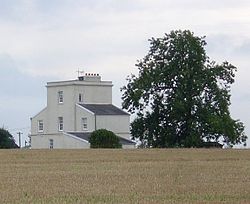Binsted
| Binsted | |
| Hampshire | |
|---|---|
 Binsted Church from the West | |
| Location | |
| Grid reference: | SU771411 |
| Location: | 51°9’50"N, -0°53’56"W |
| Data | |
| Population: | 1,871 (2011) |
| Post town: | Alton |
| Postcode: | GU34 |
| Local Government | |
| Council: | East Hampshire |
| Parliamentary constituency: |
East Hampshire |
Binsted is a village in the very east of Hampshire, some four miles east of Alton, its nearest town. The wider parish covers almost 7,000 acres and contains two villages, Bucks Horn Oak and Holt Pound, as well as two hamlets named Wyck and Wheatley. The parish also engulphs the Alice Holt Forest, a royal forest lying near the border with Surrey.
The nearest railway station is two miles north-east of the village, at Bentley. According to the 2011 census, the parish had a population of 1,817 people.
The village is first recorded in the Domesday Book of 1086. The history of Binsted from the 11th to 19th centuries is not documented, owing to its isolation and lack of involvement in notable events.
Church

The Church of the Holy Cross was built from about 1140. It has early 13th and 15th century additions, as well as a substantial restoration in 1863. The building itself consists of stone walls, a tiled roof, and a stone slated porch. The oldest part is the chancel, which dates from the 12th century with 15th century extensions. The north chapel was altered in 1331, and in its churchyard is the grave of famed Second World War Field Marshal Bernard Montgomery – Viscount Montgomery of Alamein – who latterly lived in the parish at Isington Mill.[1] The churchyard also contains the Commonwealth war graves of six British Army soldiers of First World War and a Royal Air Force airman of Second World War.[2]
The church is a Grade I listed building.[3]
History
At the time of the Domesday Book, Binsted was listed as part of the Hundred of Netham as well as the Manor of Alton Westbrook. The village was referred to as "Benested". Over the years there have been different variations on the spelling of the name, including Bensted, Benested (11th century), Bensted (14th century), and Bennsted (17th century). The name is said to have its origin in the Old English word "bin", meaning "heap".
The history of Binsted from the 11th century to the early 19th century is not documented: it was always a simple agricultural community with little of note happening so as to provoke a written record. However, the Alice Holt Forest was an important supplier of timber from the 12th and 18th centuries, and the forest was claimed to have 13,000 trees "fit for ship building" in the early 17th century.
Binsted is recorded in the Imperial Gazetteer of England and Wales by John Marius Wilson in 1870:
a parish and a subdistrict in the district of Alton, Hants. The parish lies 2½ miles SSW of Bentley r. station, and 4 NE by E of Alton; contains the hamlets of Issington, Week, Westcote, and Wheatley; and has a post office under Alton. Acres, 6,833. Real property, £7,104. Pop., 1,195. Houses, 231. Binstead Hill is the seat of the Coulthards. The living is a vicarage, united with the vicarage of Kingsley, in the diocese of Winchester. Value, not reported.* Patrons, the Dean and Chapter of Winchester. The church is ancient, has a low embattled tower and a spire, and contains several monuments. There is a Primitive Methodist chapel.-The subdistrict comprises eight parishes and an extra-parochial tract. Acres, 27,482. Pop., 4,806. Houses, 980.[4]
Five years later a school was built on land belonging to the Wickham Estate from stones brought from a pit near Semaphore House.
About the village

Telegraph House was built on the hill north-east of the village by the Admiralty in 1825, as a semaphore relay station for signalling between London and Portsmouth, one of a number of relay stations. It is now a private residence. The London to Portsmouth railway line now runs close by.
Outside links
| ("Wikimedia Commons" has material about Binsted) |
References
- ↑ Isington Mill in the Parish of Binsted: Hampshire History
- ↑ "Binsted (Holy Cross) Churchyard, with list of casualties". Commonwealth War Graves Commission. http://www.cwgc.org/find-a-cemetery/cemetery/2067515/BINSTED%20(HOLY%20CROSS)%20CHURCHYARD.
- ↑ National Heritage List 1302151: Church of the Holy Cross (Grade I listing)
- ↑ "History of Binsted in East Hampshire". University of Portsmouth. http://www.visionofbritain.org.uk/place/2342.